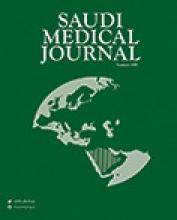Abstract
OBJECTIVE: The primary objectives were to evaluate the current usage of anti-microbial agents in the Medical Intensive Care Unit (MICU) of Hamad Medical Corporation (HMC) in Doha, State of Qatar and to correlate this with: a) the infectious disease pattern, b) the isolated microorganisms and their sensitivity pattern, and, importantly, c) the patient's clinical outcome. A secondary objective was to evaluate the influence of the use of steroid therapy on the development of fungal infections.
METHODS: A prospective study covering a 2-month period from February through April 2004, including all patients admitted to the MICU for a minimum of 48 hours, and receiving a systemic antibiotic.
RESULTS: From the 71 eligible patients admitted, 54 (76%) were treated for presumed or proven infections and received antibiotics, corresponding with 280 (89%) of the 313 patient days. Respiratory infections accounted for 57%. A total of 159 antibiotics (134 intravenously and 25 orally) were administered to the 54 patients during their stay in the MICU, corresponding with an average of almost 3 antibiotics per patient. Ceftriaxone was prescribed in 31 patients (57%) as initial therapy. Throughout the study period, a total of 385 microbiology samples for culturing were taken, corresponding with almost one sample per patient per day. Fifty-two percent of patients had a microbiologically proven infection (MPI): 18% with community-acquired pneumonia (CAP), 18% ventilated-acquired pneumonia (VAP), and 11% with hospital-acquired pneumonia (HAP). In the group of bacterial MPI, sensitivity pattern resulted in change in empirical antibiotic therapy in 12 of 23 patients (52%). In the group of patients with non-MPI, antibiotherapy was changed in 5 of the 26 patients (19%). Yeast infections developed in 13 of 30 (43%) patients receiving steroids (with 3 out of 9 patients (33%) receiving steroids for severe sepsis, and septic shock) compared to 5 of 24 (21%) patients receiving no steroids.
CONCLUSION: This study highlights the urgent need for updated empiric and treatment guidelines as well as the monitoring of the antibiotic usage.
- Copyright: © Saudi Medical Journal
This is an open-access article distributed under the terms of the Creative Commons Attribution-Noncommercial-Share Alike 3.0 Unported, which permits unrestricted use, distribution, and reproduction in any medium, provided the original work is properly cited.






